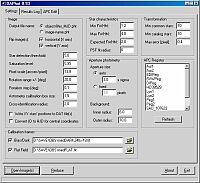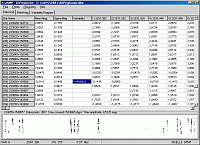|
The Semi-Automatic Variability Search Pipeline (SAVS.PL) was
developed for the SAVS sky survey purposes. It is an easy-to-use
and intuitive software which was created for semi-automatic
reduction and analysis of a large amount of CCD images and
detecting new variable stars. The package consists of two main
programs: DAPhot and JAMP. Programs run under Windows system.
DAPhot
 The DAPhot code performs standard reduction process
of raw CCD frames by removing instrumental effects such as dark
current and flat-field (both optional).
The DAPhot code performs standard reduction process
of raw CCD frames by removing instrumental effects such as dark
current and flat-field (both optional).
In an automatic way it also detects stars in each frame and
conducts precise astrometry for them by transforming instrumental
coordinates into equatorial ones and performs aperture photometry
for all detected sources. The astrometric calibration of CCD
frames bases on stars brighter than 10 mag, for which positions,
precession and proper motions are calculated from TYCHO-2
Catalogue. The typical rms error of the
transformation is 0.1 pixel. The typical for our images astrometric uncertainty
is 1 arc second. This precision makes identification of objects
unique in practice.
DAPhot measures magnitudes of stars with differential aperture
photometry against selected comparisons. Typical brightness
measurement uncertainty represented by standard deviation depends
on teh stellar brightness and ranges between 0.03 mag and 0.2 for
bright (V=8 mag) and faint (V=13 mag) stars, respectively. The
same uncertainty calculated for comparison stars does not exceed
0.03 mag.
A final output file, created for every successfully reduced frame,
is a list of detected stars saved in txt format. For every star
following data are written: equatorial coordinates for epoch
J2000.0, differential magnitude, magnitude error, approximated
FWHM of a stellar PSF and location of a star's center on an
original image. In the header of the output file some important
information about exposition are saved.
JAMP
 The JAMP interface is used for managing and
analyzing the collected data. In a fully automatic way it joins
data from single observations into databases which are separately
created for every observed field. The candidates for variable
stars are selected by the analysis of variance (ANOVA) method.
The application is also used as a
viewer of the content of databases.
The JAMP interface is used for managing and
analyzing the collected data. In a fully automatic way it joins
data from single observations into databases which are separately
created for every observed field. The candidates for variable
stars are selected by the analysis of variance (ANOVA) method.
The application is also used as a
viewer of the content of databases.
Download our software
The SAVS pipeline - SAVS.PL - is not a bug-free software. However, if you find it interesting and useful, you can download the release version:
The SAVS.PL package is provided as a freeware and "as-is". No warranty of any kind is expressed or implied.
PerSea
To perform a detailed period analysis for selected variable
candidates we also developed a tool PerSea.
It is based on the analysis of variance (ANOVA) algorithm adopted from ISIS package.
The latest executable is available here (1.4 MB).
| 
